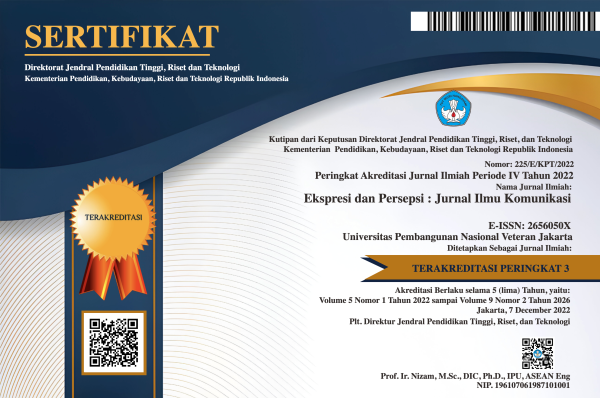Revealing the Trauma of Sexual Harassment Against Men in the Film Dear David (Semiotic Analysis of Roland Barthes)
DOI:
https://doi.org/10.33822/jep.v7i2.7559Keywords:
Sexual harassment, semiotics, Dear David film, representationAbstract
As a mass media outlet, films are entertaining and provide information for the public. This research examines the film Dear David, which was shown on a digital platform and directed by Lucky Kuswandi and intended to convey a message about men being victims of sexual harassment. This research aims to determine the representation of sexual harassment towards men conveyed in a film. This research uses Roland Barthes' semiotic theory to analyze the representation of sexual harassment against men in the film Dear David. Seven scenes were found that depicted the reality of sexual harassment experienced by the character and ended up causing trauma. The results of this research are the issue of sexual harassment by men where there is a stigma of toxic masculinity, which emphasizes that men are strong and should not appear weak so that patriarchal culture means that victims are often ignored and do not receive attention.
References
Alfathoni, M. A. M., & Manesah, D. (2020). Pengantar Teori Film. Penerbit Deepublish.
Arimbi, D. (2023, February 21). Keramaian Warganet Kritisi Film Dear David: Kurang Puas dengan Eksekusi Isu KBGO dan LGBT. Netray Media Monitoring. https://analysis.netray.id/review-film-dear-david/
Asti, G. K., Febriana, P., & Aesthetika, N. M. (2021). Representasi Pelecehan Seksual Perempuan Dalam Film. Komuniti: Jurnal Komunikasi Dan Teknologi Informasi, 13(1), 79–87.
Barthes, R. (1987). Elements of Semiology. Hill and Wang.
Boyle, M., Koritsas, S., Coles, J., & Stanley, J. (2007). A pilot study of workplace violence towards paramedics. Emergency Medicine Journal, 24(11), 760–763. https://doi.org/10.1136/emj.2007.046789
Bruschini, M. M., Hediger, H., & Busch, A. K. (2023). Patients’ sexual harassment of nurses and nursing students: A cross-sectional study. International Journal of Nursing Studies Advances, 5. https://doi.org/10.1016/j.ijnsa.2023.100121
Ervinda, M. D., Putri, R. E., & Pandin, M. G. R. (2021). Catcalling as A Representation of The Strong Patriarchal Culture in The Perspective of Feminism. https://doi.org/10.20944/preprints202104.0789.v1
Espino, E., Ortega-Rivera, J., Ojeda, M., Sánchez-Jiménez, V., & Del Rey, R. (2022). Violence among adolescents: A study of overlapping of bullying, cyberbullying, sexual harassment, dating violence and cyberdating violence. Child Abuse and Neglect, 134. https://doi.org/10.1016/j.chiabu.2022.105921
Hidayat, A., & Setyanto, Y. (2019). Fenomena Catcalling sebagai Bentuk Pelecehan Seksual secara Verbal terhadap Perempuan di Jakarta. Koneksi, 3(2), 485–492.
Jones, L., Chałupnik, M., Mackenzie, J., & Mullany, L. (2022). ‘STFU and start listening to how scared we are’: Resisting misogyny on Twitter via #NotAllMen. Discourse, Context and Media, 47. https://doi.org/10.1016/j.dcm.2022.100596
Kane, D., Kennedy, K. M., Flood, K., & Eogan, M. (2024). Male patient attendances at Sexual Assault Treatment Units in Ireland: An analysis of 381 cases and a comparison with female patients. Journal of Forensic and Legal Medicine, 102. https://doi.org/10.1016/j.jflm.2024.102643
Komnas Perempuan. (2022). 15 Bentuk Kekerasan Seksual: Sebuah Pengenalan.
Konlan, K. D., & Dangah, M. M. (2023). Students’ experiences of sexual harassment; a descriptive cross-sectional study in a college of education, Ghana. Heliyon, 9(4). https://doi.org/10.1016/j.heliyon.2023.e14764
Lacroix, E., Nahmani, I., Rebut, D., & Fanton, L. (2020). New measures introduced by Law no. 2018-703 relating to sexual and gender-based violence. Revue de Medecine Legale, 11(3), 100–106. https://doi.org/10.1016/j.medleg.2020.05.001
Langdridge, D., Flowers, P., & Carney, D. (2023). Male survivors’ experience of sexual assault and support: A scoping review. In Aggression and Violent Behavior (Vol. 70). Elsevier Ltd. https://doi.org/10.1016/j.avb.2023.101838
Lubis, N. L. (2013). Psikologi Kespro: Wanita & Perkembangan Reproduksinya (Edisi Pertama). KENCANA.
Madrid, B. J., Lopez, G. D., Dans, L. F., Fry, D. A., Duka-Pante, F. G. H., & Muyot, A. T. (2020). Safe schools for teens: preventing sexual abuse of urban poor teens, proof-of-concept study - Improving teachers’ and students’ knowledge, skills and attitudes. Heliyon, 6(6). https://doi.org/10.1016/j.heliyon.2020.e04080
Mughni, D. N., & Faridah, H. (2023). Kebijakan Hukum Pelecehan Seksual (Cat Calling) dalam Persektif Hukum Pidana di Kabupaten Karawang. Jurnal Ilmiah Wahana Pendidikan, 9(1), 118–127. https://doi.org/10.5281/zenodo.7519146
Pan, X., Hou, Y., & Wang, Q. (2023). Are we braver in cyberspace? Social media anonymity enhances moral courage. Computers in Human Behavior, 148, 107880. https://doi.org/10.1016/j.chb.2023.107880
Peraturan Menteri Pendidikan, Kebudayaan, Riset, Dan Teknologi Republik Indonesia Nomor 30 Tahun 2021 Tentang Pencegahan Dan Penanganan Kekerasan Seksual Di Lingkungan Perguruan Tinggi, 1 (2021). https://www.kemdikbud.go.id/main/blog/2021/11/permen-pencegahan-dan-penanganan-kekerasan-seksual-di-lingkungan-perguruan-tinggi-tuai-dukungan
Prichard, I., Taylor, B., & Tiggemann, M. (2023). Comparing and self-objectifying: The effect of sexualized imagery posted by Instagram Influencers on women’s body image. Body Image, 46, 347–355. https://doi.org/10.1016/j.bodyim.2023.07.002
Quinones, L. M. (2020). Sexual harassment in public transport in Bogotá. Transportation Research Part A: Policy and Practice, 139, 54–69. https://doi.org/10.1016/j.tra.2020.06.018
Rainn. (2023). Sexual Harassment. Rainn.Org. https://www.rainn.org/articles/sexual-harassment#:~:text=What%20is%20sexual%20harassment%3F,Employment%20Opportunity%20Commission%20(EEOC).
Sugiyono. (2013). Metode Penelitian Kuantitatif, Kualitatif dan R&D. Penerbit Alfabeta.
Trudgett-Klose, L. H., & McLinton, S. S. (2024). “Pro Gamers” & Cyberbullying: Workplace bullying & sexual harassment in professional video gaming. Entertainment Computing, 50, 100702. https://doi.org/10.1016/j.entcom.2024.100702
Undang Undang No 12 Tahun 2022 Tentang Tindak Pidana Kekerasan Seksual, 1 (2022). https://jdih.setneg.go.id/
Walton, K. A., & Pedersen, C. L. (2021). Motivations Behind Catcalling: Exploring Men’s Engagement in Street Harassment Behaviour. Psychology and Sexuality, 13(3), 689–703. https://doi.org/10.1080/19419899.2021.1909648
Wibowo, I. S. W. (2013). Semiotika Komunikasi: Aplikasi Praktis Bagi Penelitian dan Skripsi Komunikasi (Edisi 2). Mitra Wacana Media.
Wirman, W., Sari, G. G., Hardianti, F., & Roberto, T. P. (2021). Dimensi Konsep Diri Korban Cyber Sexual Harassment di Kota Pekanbaru. Jurnal Kajian Komunikasi, 9(1), 79–93. http://jurnal.unpad.ac.id/jkk/article/view/27363/15566
Downloads
Published
Issue
Section
License
Copyright (c) 2024 Elsa Damayanti, Vinta Sevilla

This work is licensed under a Creative Commons Attribution-NonCommercial 4.0 International License.














